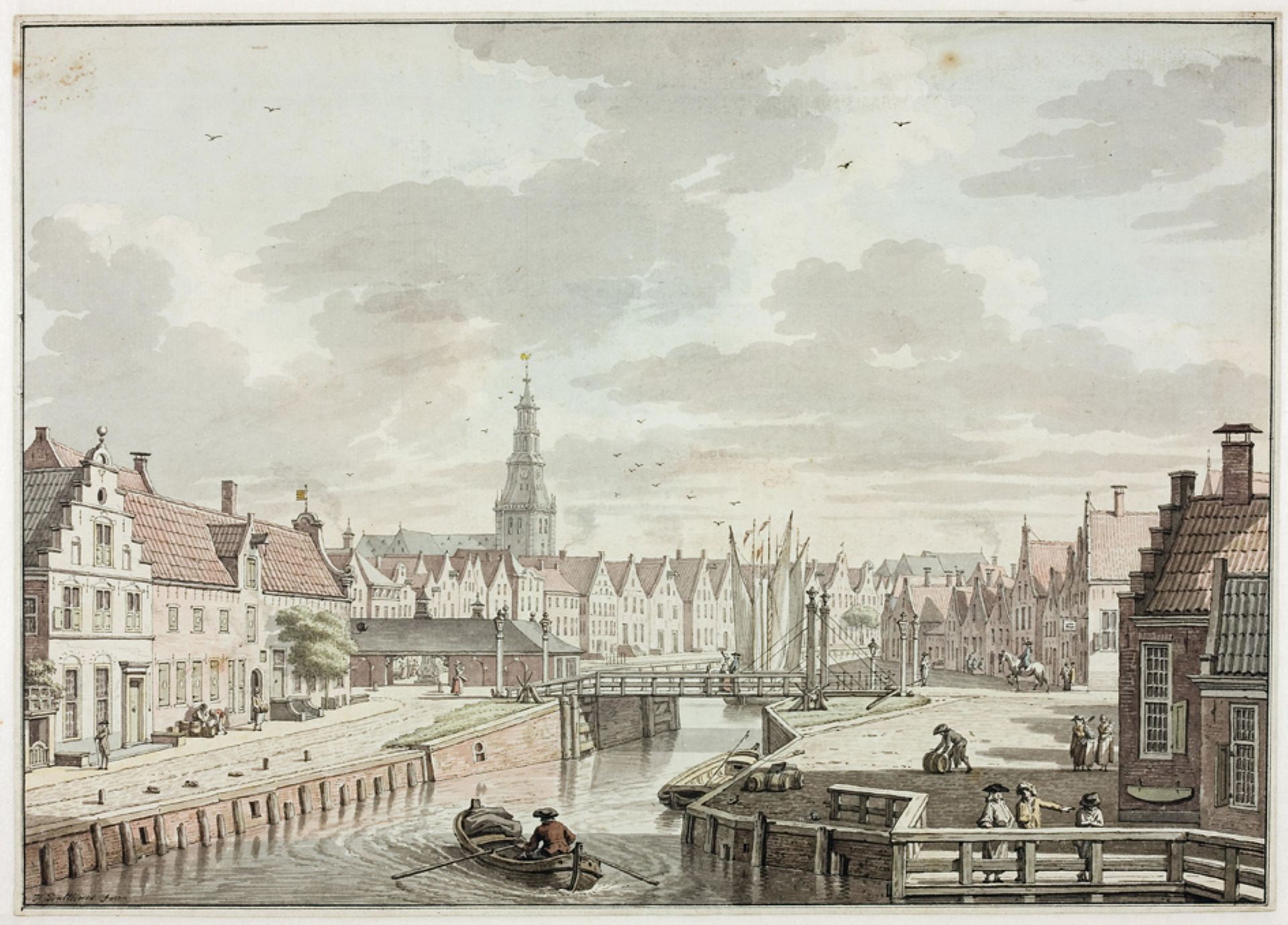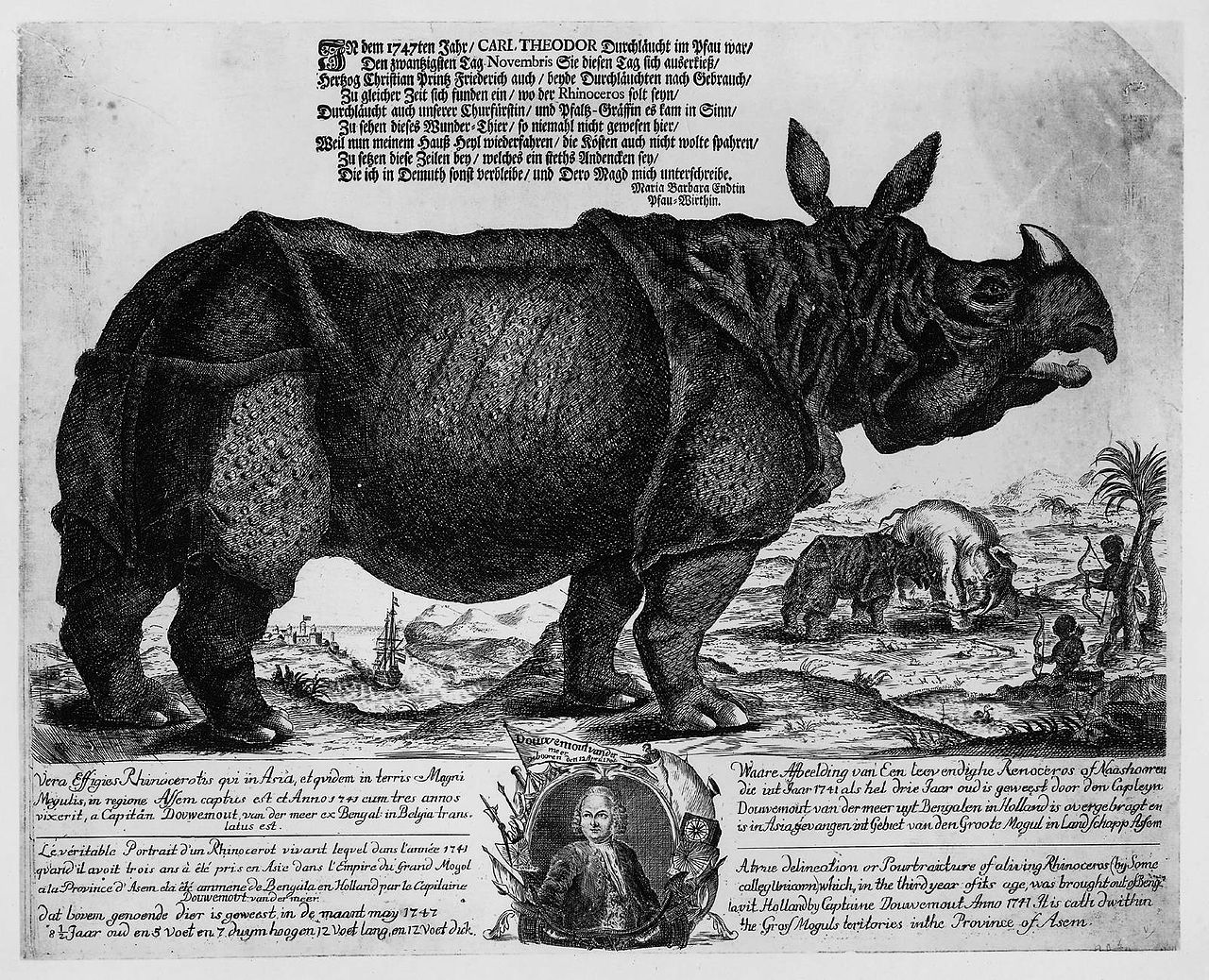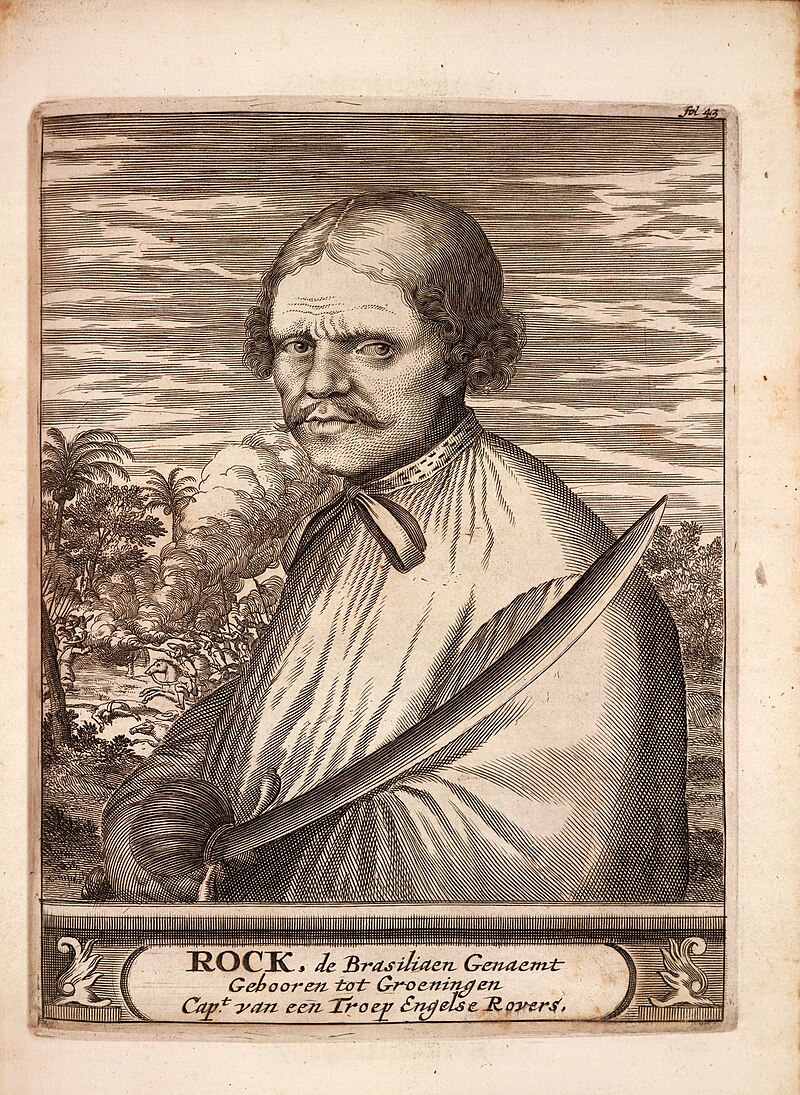
![]()
Deze eenvoudige multi van 2,5 km leidt je langs een aantal waypoints in het centrum waar ik jullie probeer te informeren en amuseren met een verhaaltje over een stukje Groningse geschiedenis. De route voert langs de 3 virtual caches en 5 lab caches in het centrum.

![]()
This easy multi of 2.5 km will lead you along a few waypoints where I will try to inform and amuse you with stories about the history of Groningen. On the route you will also encounter the 3 virtual caches and 5 lab caches in the city center.
wp1: WIC-kantoor Groningen Munnekeholm (1622 - 1791)


![]()
Je staat hier op de plek waar vroeger het Groningse pand van de West-Indische Compagnie (WIC) stond. Tijdens de oprichting van de bekende VOC waren Groningen en Friesland al buiten de boot gevallen. Dat wilden ze niet opnieuw en daarom eisten zij dat zij ook een zogenaamde 'Kamer' in het bestuur van de WIC kregen. Met uiteindelijk slechts 1/9 inbreng kregen zij dat met moeite voor elkaar.
Het doel van de WIC was het veroveren van de rijkdommen van Spanje en Portugal in West-Indië. Initieel is dit heel succesvol. Met de verovering van de Zilvervloot is er genoeg geld om hele stukken Brazilië te veroveren.
In het begin vertrekken de boten vanuit Groningen maar door dichtslibben en de verdedigingswerken wordt Groningen steeds lastiger te bereiken totdat WIC kamer ter Stad en Lande besluit Delfzijl als haven te gebruiken. Dit lag gevoelig want de stadjers gunden de Ommelanders geen handelshaven
De niet aflatende guerrillaoorlog van de Portugezen tegen de Nederlanders liep uit op een ware uitputtingsslag. Voor de WIC liepen de kosten van de strijd in Brazilië zo hoog op dat de Compagnie steeds maar weer geld moest lenen. Toen de Republiek der Nederlanden in 1652 ook nog eens in oorlog met Engeland was capituleerden Recife en alle nog in Nederlandse handen zijnde plaatsen in 1654 voor een overmacht van Portugese schepen.
De WIC hield zich tot 1791 bezig met slavenhandel en het bestuur van de Antilliaanse eilanden en de Zuid-Amerikaanse koloniën
Van 1803 tot 1903 was het Academisch Ziekenhuis in dit pand gevestigd en van 1909 tot 2009 het hoofdpostkantoor van Groningen. Nu is het een fitness centrum.
Vraag: Welk bouwjaar staat rechts van de ingang gebeiteld?

![]()
You are standing here where the Groningen building of the Dutch West India Company (WIC) used to be. During the establishment of the well-known VOC, Groningen and Friesland had already missed the boat. They did not want that to happen again and therefore demanded that they also receive a so-called 'Chamber' on the WIC board. With only 1/9 input, they managed to achieve that with difficulty.
The purpose of the WIC was to conquer the riches of Spain and Portugal in the West Indies. Initially this is very successful. With the conquest of the Silver Fleet there is enough money to conquer entire sections of Brazil.
In the beginning, the boats depart from Groningen, but due to silting up and the city defenses, it is becoming increasingly difficult to reach Groningen until the WIC chamber, ter Stad en Lande, decides to use Delfzijl as a port. This was a sensitive issue, because the Stadjers (city dwellers) did not want the Ommelanders (people living in the surrounding area of Groningen) to have a trading port.
The relentless guerrilla war of the Portuguese against the Dutch led to a real exhaustion battle. For the WIC the costs of the struggle in Brazil were so high that the Company had to borrow money again and again. When the Republic of the Netherlands was at war with England in 1652, Recife and all places still in Dutch hands capitulated in 1654 for a force majeure of Portuguese ships.
The WIC was involved in the slave trade and administration of the Antillean islands and the South American colonies until 1791.
From 1803 to 1903 the Academic Hospital was located in this building and from 1909 to 2009 the main post office of Groningen. Now it is a fitness center.
Question: Which year is chiseled to the right of the entrance?
wp2: Hoge en Lage der A


![]()
De Hoge en Lage der A zijn de 2 kades aan weerszijden van de Drentsche Aa tussen de Brugstraat en de Visserstraat. De Aa gaat over in het Reitdiep, dat al slingerend uitkwam op de Lauwerszee bij Zoutkamp.
De naamgeving komt waarschijnlijk van het feit dat bij vloed er aan de hoge oostzijde geladen en gelost kon worden en bij eb aan de lage westzijde. Totdat het Reitdiep in 1877 werd afgedamd was er namelijk sprake van eb en vloed in de stad.
Aan deze historische kades zie je nog steeds duidelijk dat de panden vroeger dienden als pakhuizen. Deze zijn in de jaren ’70 omgebouwd tot woonhuizen met verschillende appartementen.
Bij Hoge der A 19 kunt je nog een zwarte paal met sleuf zien, waarin men vroeger een vloedplank plaatste als zelfs de hoge kade dreigde te overstromen!
Vraag: Wat is de woordwaarde van het tot appartementen omgebouwde pakhuis aan de overkant van het water?
Loop nu door de Turftorenstraat via reference points 3 en 4 naar wp5.

![]()
The Hoge and Lage der A are the 2 quays on either side of the Drentsche Aa between Brugstraat and Visserstraat. The Aa changes into the Reitdiep, which meandered before it emerged into the Lauwers Sea near Zoutkamp.
The naming probably comes from the fact that with high tide it was possible to load and unload on the high east side and with low tide on the low west side. Until the Reitdiep was dammed in 1877 there was ebb and flow in the city.
On these historic quays you can still clearly see that the buildings used to serve as warehouses. These were converted into residential houses with different apartments in the 1970s.
At Hoge der A 19 you can still see a black pole with a slot, in which people used to place a flood board if even the high quay threatened to flood!
Question: What is the word value of the warehouse that has been transformed into appartements on the other side of the water ?
Walk through Turftorenstraat via reference points 3 and 4 to wp5.
wp5: Neushoorn Clara (1738 - 1758)


![]()
Je staat hier voor het huis (het Sichtermanhuis) waar ooit Jan Albert Sichterman woonde, de directeur van de VOC-vestiging in de Bengalen. In de Bengalen had hij een neushoorn, genaamd Clara, als huisdier die ongehinderd door het huis mocht lopen. Hij verkocht Clara aan kapitein Douwe Mout van der Meer.
Deze nam haar per boot mee naar Nederland om haar tentoon te stellen. Dit was zo succesvol dat hij ontslag nam om fulltime met Clara door Europa te reizen. Vrijwel alle koningshuizen werden bezocht (Clara was de 5e levende neushoorn in Europa en voor veel mensen de eerste kans om er een in levenden lijve te zien) en ze leverde veel geld op. De stad Groningen werd zelfs 2 keer aangedaan. Clara stierf in Londen op 21 jarige leeftijd.
Vraag: Van welk jaartal is het voormalige koetshuis, links van het Sichtermanhuis?
Loop nu via reference point 6 naar wp7.
Als u heel scherp bent, ontdekt u op de gevel van Oude Ebbingestraat 52 nog een reliëf (de linker) van Johannes de Doper.

![]()
You are standing here in front of the house (the Sichterman House) where Jan Albert Sichterman once lived, the director of the VOC branch in the Bengal. In the Bengal he had a rhino, named Clara, as a pet that was allowed to walk around the house unhindered. He sold Clara to Captain Douwe Mout van der Meer.
He took her by boat to the Netherlands to exhibit her. This was so successful that he resigned to travel full-time with Clara through Europe. Almost all royal houses were visited (Clara was the 5th living rhino in Europe and for many people the first chance to see one in the flesh) and she raised a lot of money. The city of Groningen was even visited twice. Clara died in London at the age of 21.
Question: In which year was the former coach house built, to the left of the Sichtermanhuis?
Walk via reference point 6 to wp7.
If you are very sharp, you will discover a relief (the left) of John the Baptist on the facade of Oude Ebbingestraat 52.
wp7: de arm van Johannes de Doper (1220 - 1594)


![]()
De Martinikerk, of de St. Maartenskerk zoals deze toen heette, bezat vanaf circa 1220 een belangrijk reliek, nl. de arm van St. Jan de Doper, bewaard in een kostbare reliekhouder.
Mensen kwamen van heinde en verre op bedevaart naar de kerk om de arm te bezichtigen voor een aflaat van de paus van 40 dagen (die je minder lang in het vagevuur hoefde door te brengen). De toestroom van pelgrims leidde tot de bouw van allerlei gasthuizen.
Toen men in 1594 met het katholicisme brak was er geen plek meer voor de arm en is hij verloren gegaan. Tegenwoordig herinnert alleen de Sint Jansstraat nog aan deze devotie.
Vraag: Uit hoeveel kleuren bestaat het smeedijzeren hekwerk met de beeltenis van Johannes de Doper? (Saillant detail: hij wijst met zijn arm naar waar zijn arm lag)

![]()
The Martini Church, or the St. Maartenskerk as it was then called, had an important relic from about 1220, namely the arm of St. John the Baptist, kept in a precious reliquary.
People came from far and wide on a pilgrimage to the church to see the arm for a 40-day indulgence of the pope (which you had to spend less in purgatory). The influx of pilgrims led to the construction of all kinds of guest houses.
When people broke with Catholicism in 1594, there was no place left for the arm and it was lost. Nowadays only the name of the Sint Jansstraat reminds us of this devotion.
Question: How many colors does the wrought-iron railing with the image of John the Baptist have? (Salient detail: he points with his arm to where his arm was)
wp8: Rock Brasiliano (1635 - 1671)


![]()
Rock de Braziliaan werd geboren in Groningen maar groeide op in de Nederlandse kolonie in Brazilie.
Om in zijn levensonderhoud te voorzien, sloot hij zich aan bij boekaniers. Hij begon als matroos maar won al snel het respect van zijn collega's. Toen aan boord van het schip een muiterij ontstond, kozen de opstandelingen hem als leider. In een kleine sloep wisten ze daarna een groot schip te veroveren dat beladen met zilver op weg was vanuit Nieuw-Spanje (het huidige Mexico). Hij werd een beruchte en zeer gevreesde piraat. Vooral de Spanjaarden moesten het ontgelden.
Bekend is dat zijn boot in een storm verging. Met 30 man wist Rock met slechts wat wapens en kruit toch nog de kust te bereiken waar ze werden opgejaagd door 100 Spanjaarden te paard. Maar dan kenden ze Rock nog niet. Hij versloeg ze en wist weer een boot te veroveren zodat hij weer verder kon met piraterij.
Een andere keer werden ze gevangen genomen door de gouverneur van Campeche terwijl ze de haven inspecteerden op buit. Ze werden in een kerker geworpen en wachtten op een zekere dood, maar Rock verzon een list en liet een door hemzelf geschreven brief naar buiten smokkelen waarin zogenaamde piratenvrienden van hem de stad met de grond gelijk dreigden te maken als Rock en zijn mannen niet vrij gelaten zouden worden. De gouverneur trapte erin en liet ze vrij op voorwaarde dat ze niet meer gingen kapen. Waarschijnlijk had Rock, toen hij dat plechtig beloofde, zijn vingers gekruist op de rug want het eerste wat hij deed toen ze vrij waren was een boot kapen om weer verder te gaan met piraterij.
Over het eind van zijn leven doen verschillende versies de ronde. Sommigen beweren dat hij met zijn schip verdwenen is op zee, anderen zeggen dat hij zijn laatste levensdagen sleet als bedelaar in de straten van Port Royal.
Een aantal films, boeken en computergames zijn gebaseerd op Rock.
Vraag: Aan de overkant van het water zie je een boot met een dier. Wat is de tot 1 cijfer gestapeltelde waarde van de Engelse naam van het dier?

![]()
Rock de Brazilian was born in Groningen but grew up in the Dutch colony in Brazil.
To support himself, he joined buccaneers. He started out as a sailor but soon won the respect of his colleagues. When a mutiny arose aboard the ship, the insurgents chose him as leader. In a small sloop, they then managed to capture a large ship laden with silver on its way from New Spain (present-day Mexico). He became a notorious and very feared pirate. Especially the Spaniards had to suffer.
It is known that his boat crashed in a storm. With 30 men, Rock managed to reach the coast with only a few weapons and gunpowder where they were hunted by 100 Spaniards on horseback. But then they didn't know Rock yet. He defeated them and managed to capture another boat so that he could continue with piracy.
Another time they were captured by the governor of Campeche while inspecting the port for loot. They were thrown into a dungeon and waited for a certain death, but Rock came up with a trick and had a letter written by himself smuggled out in which so-called pirate friends threatened to destroy the city if Rock and his men were not released. The governor was fooled and released them on the condition that they would stop hijacking boats. Probably, when he solemnly promised to do so, Rock had crossed his fingers on the back because the first thing he did when they were free was to hijack a boat to resume piracy.
Different versions are circulating around the end of his life. Some claim that he and his ship have disappeared at sea, others say he spends his last days as a beggar in the streets of Port Royal.
A number of films, books and computer games are based on Rock.
Question: At the other side of the water you can see a boat with an animal. What is the value of the English name of this animal summed to 1 digit?

![]()
Om de cache te kunnen vinden moet je een Gade oplossen. Schrijf alle cijfers van alle antwoorden die je gevonden hebt van klein naar groot op onder de letters A, B, C etc. Stel je hebt de antwoorden 1882, 4, 33, en 9 gevonden dan schrijf je ze als 1 2 3 3 4 8 8 9 onder A t/m H. Zie:

![]()
To find the cache you have to solve a Gade. Write all the digits of all the answers you have found in alphanumeric order under the letters A, B, C etc. Suppose you have found the answers 1882, 4, 33, and 9 then write them as 1 2 3 3 4 8 8 9 under A to H. See:
| A |
B |
C |
D |
E |
F |
G |
H |
| 1 |
2 |
3 |
3 |
4 |
8 |
8 |
9 |

![]()
Vul daar achter onder I t/m L de nog ontbrekende cijfers (0, 5, 6, 7) in, wederom van klein naar groot. Dan krijg je:

![]()
Enter the missing digits (0, 5, 6, 7) below I to L in alphanumeric order. Then you get:
| A |
B |
C |
D |
E |
F |
G |
H |
I |
J |
K |
L |
| 1 |
2 |
3 |
3 |
4 |
8 |
8 |
9 |
0 |
5 |
6 |
7 |

![]()
Hieronder de Gade voor het berekenen van de coordinaten van deze cache:

![]()
Below the Gade for calculating the coordinates of this cache:
| A |
B |
C |
D |
E |
F |
G |
H |
I |
J |
K |
L |
M |
N |
O |
| |
|
|
|
|
|
|
|
|
|
|
|
|
|
|

![]()
De cache is te vinden op N53 1N.EBH E006 3G.NIG

![]()
The cache can be found at N53 1N.EBH E006 3G.NIG